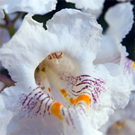Catalpa Tree Family
The Catalpa tree family genus dates back to the Tertiary period and its fossil remains have been discovered in the rocks of Yellowstone river. This tree belongs to the Bignoniaceae vine family, and it often refereed with names like catawba, cigar tree or fish bait tree. In the South, Catalpa worms, the larvae of Catalpa Sphinx Moths are highly sought after by anglers as fish bait.
The Catalpa trees have large, spectacular flowers that come in late Spring to early Summer. Catalpa trees have a large crown that is rounded and upright with heart shape medium flowers. The flowers of Catalpa trees have white petals and spots of yellow with purple dots. The large leaves make for a great shade tree. A unique feature of the Catalpa trees are the bean pods that appear later in the season. The sweet fragrance attracts bees, butterflies and hummingbirds. Catalpa wood is also valued. It is lightweight and has a soft rich luster. Its grain pattern flutters around with the light and when rubbed to a rich finish, it has the texture of pure silk. The wood is also used for posts and fence rails, as well as interior finishes for cabinetry.
The Catalpa tree varieties are easy to transplant and grow in many types of soils making this a very desirable tree for homeowners. They can withstand wet, dry alkaline soils and hot, dry environments also but prefer moist, deep, well drained soil. They grow in sun or partial shade. Being easily adaptable makes them a prized landscape tree.
These types of Catalpa trees are an excellent choice if fast growth is desired. Catalpa tree varieties can withstand city conditions while adding beauty to landscapes. Another great feature of the catalpa trees is its strong extensive root system can prevent soil erosion.
Willis Orchard Company offers three of the best varieties of the Catalpa tree, the American, the Purple and the Umbrella. Any of these three would be an excellent choice for your home or business.
